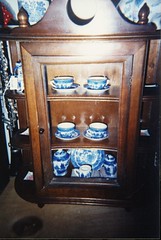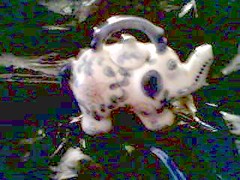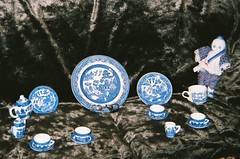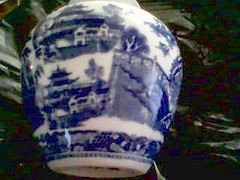I planned on using that memory to write my Nanowrimo novel. My husband and I went to the antique store to get a plate to use as a muse. I got a cup and a plate.
Then, some dear friends surprised me with a birthday present of a miniature tea set!!! I was overwhelmed ...and surprised ...and delighted! My therapist, who collects blue willow, gave me a bread and butter plate to also use as a muse.
So ..suddenly, my love of blue willow went from a love, fond (if embarrasing) memories to a minor collection of this china I loved so much!
Then it kind of ...well ... blew up ... I realized that just because I hadn't been collecting since my childhood (like my elephants) did not mean it was too late to start. I also realized that just because I had an elephant collection did not mean that I could not have my blue willow too!

So now ... I have
2 plates, 10 inches from Churchill England
2 saucers from the Royal China Company (with a mark they used from 1920 to 1949.
1 Soup Bowl from the Royal China Company (same mark)
2 tea cups from Churchill England
1 Saucer frm Churchill England

1 Miniature tea set
4 cups, 4 saucers, tea pot, sugar bowl, creamer jar and cookie plate.
1 Bread and butter plate from The Royal China Company
1 Miniature tea set cookie plate with stamp from Japan (blue)
1 Vase 8 inches tall, with Ironstone stamp on it.
1 Bread and butter plate with stamp from Japan (black)

Plus and elephant in blue and white china, but different pattern.

I really really want to find a blue willow elephant!! Although, I have the feeling that if I did so, it'd be quite costly, the cats and cows are worth a small fortune!
I have enjoyed, as much as acquiring the plates, learning about the different types of blue willow:
Traditional,
Two Temples 1
Two Temples 2
Manderin
Worcster
Burleigh
Turner
Simplified
Polychrome
Canton

The different borders:
Traditional
Butterfly or Insect
Fitzhugh
Bow Knot
Dagger
Scroll and Flowers
Floral
Pictoral
Simple Line
Borderless
And different manufactures used different patterns ... so just because you have a Churchill England, doesn'[t mean the very next Churchill England plate will have the same pattern!!
The vase I have, has a Two Temple's 2 design
while most of the others have a traditional,
Some plates have thin birds, others have fat birds ...some have no birds.

Looking at the different designs for how many people ... the Two Temples 2 has only 2 people on the bridge, and the traditional has 3.


Doing research to find the different blue willow legends
This one comes off the back of the Mary Gaston Blue Willow book (value guide)

The Legend
Once upon a time there lived a very wealthy manderin who had a beautiful
daughter, Hong Shee. There was aslo a boy named Change who loved Hong Shee. To
keep them apart, the manderin imprisoned his daughter in the palace.
One day, she escaped adn the two lovers raced over the bridge to a waiting
boat, her father in hot persuit. They managed to elude the manderin, reach the
boat and sail away.
A storm developed, the boat foundered and the couple were lost at sea. It
is said two love birds immediately appeared thereafter - the spirits of Hong
Shee and Chang.Another legend goes
"The Willow Legend"
Long ago in China, in a magnificent palace surrounded by
trees, lived a Mandarin, his daughter, Koong-shee, and his secretary, Chang.
Chang and Koong-shee fell in love, but Chang was a commoner and she the daughter
of a noble. Still their love grew as they met beneath a willow tree in the
garden. When the Mandarin discovered their secret, he banished Chang &
imprisoned Koong-shee by encircling the palace with a zig-zag fence.
Then he
promised her hand to another. He had a feast to celebrate and after, when all
fell asleep, Chang crept into the palace and fled with Koong-shee, The Mandarin
awoke and pursued them across the little bridge that spans the river.
The lovers escaped, but soon the Mandarin discovered where they were
hiding and sent his men to kill the couple. They came upon Chang as he was
working his fields and killed him. Koong-shee, who had seen the entire scene
from afar, rushed into the pavilion and set it afire. She was determined to be
with Chang in death as she had been in life.
The gods, looking down on the
tragedy, took pity on the lovers and transformed their souls into a pair of
immortal lovebirds to forever live in the pagoda.
Yet another legend:
The Romantic Fable: Once there was a wealthy Mandarin, who
had a beautiful daughter (Koong-se). She had fallen in love with her father's
humble accounting assistant (Chang), angering her father (it was inappropriate
for them to marry due to their difference in social class). He dismissed the
young man and built a high fence around his house to keep the lovers apart. The
Mandarin was planning for his daughter to marry a powerful Duke. The Duke
arrived by boat to claim his bride, bearing a box of jewels as a gift. The
wedding was to take place on the day the blossom fell from the willow
tree.
On the eve of the daughter's wedding to the Duke, the young accountant,
disguised as a servant, slipped into the palace unnoticed. As the lovers escaped
with the jewels, the alarm was raised. They ran over a bridge, chased by the
Mandarin, whip in hand. They eventually escaped on the Duke's ship to the safety
of a secluded island, where they lived happily for years. But one day, the Duke
learned of their refuge. Hungry for revenge, he sent soldiers, who captured the
lovers and put them to death. The Gods, moved by their plight, transformed the
lovers into a pair of doves (possibly a later addition to the tale, since the
birds do not appear on the earliest willow pattern plates).Another legend
The old poem:
Two birds flying high,
A Chinese vessel, sailing by.
A bridge with three men, sometimes four,
A willow tree, hanging o'er.
A Chinese temple, there it stands,
Built upon the river sands.
An apple tree, with apples on,
A crooked fence to end my song.
There are many many many more....
The saddest thing that I learned was that ... the legends did not come first. The legends (and the pattern) originated in England! The plate came first, the legend second as a marketing ploy (obviously, a good one!!)
No one knows what the original legend was ... but we do know that Spode was the first person to design blue willow.
They are mostly in colbolt blue because back then, blue was the only color that could survive the firing process. They used to all be hand painted, then in the late 1700's a way of decorating china and potter called "Transferware" became available ...transfering the design onto the china.
Some designs are hand painted, some are stenciled and some are transfer ware ...
It's all very interesting to look and figure out what is what.
There are very few fakes in Blue Willow ...and those are fakes of manufactures trying to make newer pottery look older. The reality is a blue willow is a blue willow regardless of who makes it. As long as you know your marks, and which ones are actually newer ones, trying to copy older ones ... then you know what you have.
So, no matter what Blue Willow you have, it's still a blue willow. Period.
It is also one that relatively few tried to fake because the pattern is so complicated. Most pottery companies who did it, wanted their own credit for the piece of china or pottery. Since anyone could make one, there was not enough reason to make a forgery. Some did and do ... but it is an attempt to make the collector think they have an older piece. Some of those, are quite valuable because they are few and far inbetween.
Some collectors just get a particular design ...
some from just one company
some get any blue willow (me)
and some collect blue and white china of all designs (flow blue, etc)





No comments:
Post a Comment